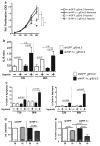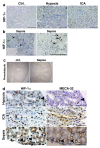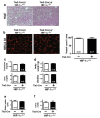Kidney injury is independent of endothelial HIF-1α
- PMID: 25754172
- PMCID: PMC6592817
- DOI: 10.1007/s00109-015-1264-4
Kidney injury is independent of endothelial HIF-1α
Abstract
Hypoxia-inducible transcription factors (HIFs) control cellular adaptation to low oxygen. In the kidney, activation of HIF is beneficial during injury; however, the specific contribution of HIF-1α in renal endothelial cells (EC) remains elusive. Since EC display tissue-specific heterogeneity, we investigated how HIF-1α affects key functions of glomerular EC in vitro and its contribution to renal development and pathophysiological adaptation to acute or chronic renal injury in vivo. Loss of HIF-1α in glomerular EC induces hypoxic cell death and reduces hypoxic adhesion of macrophages in vitro. In vivo, HIF-1α expression in EC in mouse kidneys is detectable but limited. Accordingly, EC-specific ablation of HIF-1α does not lead to developmental or phenotypical abnormalities in the kidney. Renal function and expression of adhesion molecules during acute ischemic kidney injury is independent of HIF-1α in EC. Likewise, inflammation and development of fibrosis after unilateral ureteric obstruction is not influenced by endothelial HIF-1α. Taken together, although HIF-1α exerts effects on glomerular EC in vitro, endothelial HIF-1α does not influence renal development and pathophysiological adaptation to kidney injury in vivo. This implies a profound difference of the hypoxic response of the renal vascular bed compared to other organs, such as the heart. This has implications for the development of pharmacological strategies targeting the endothelial hypoxic response pathways.
Key message: HIF-1α controls hypoxic survival and adhesion on endothelial cells (EC) in vitro. In vivo, HIF-1α expression in renal EC is low. Deletion of HIF-1α in EC does not affect kidney development and function in mice. Renal function after acute and chronic kidney injury is independent of HIF-1α in EC. Data suggest organ-specific regulation of HIF-1α function in EC.
Figures






Similar articles
-
Renal Protection Mediated by Hypoxia Inducible Factor-1α Depends on Proangiogenesis Function of miR-21 by Targeting Thrombospondin 1.Transplantation. 2017 Aug;101(8):1811-1819. doi: 10.1097/TP.0000000000001501. Transplantation. 2017. PMID: 28737660 Free PMC article.
-
Endothelial HIF-2 mediates protection and recovery from ischemic kidney injury.J Clin Invest. 2014 Jun;124(6):2396-409. doi: 10.1172/JCI69073. Epub 2014 May 1. J Clin Invest. 2014. PMID: 24789906 Free PMC article.
-
Cilastatin Preconditioning Attenuates Renal Ischemia-Reperfusion Injury via Hypoxia Inducible Factor-1α Activation.Int J Mol Sci. 2020 May 19;21(10):3583. doi: 10.3390/ijms21103583. Int J Mol Sci. 2020. PMID: 32438631 Free PMC article.
-
The role and regulation of hypoxia-inducible factor-1alpha expression in brain development and neonatal hypoxic-ischemic brain injury.Brain Res Rev. 2009 Dec 11;62(1):99-108. doi: 10.1016/j.brainresrev.2009.09.006. Epub 2009 Sep 25. Brain Res Rev. 2009. PMID: 19786048 Review.
-
HIF-1α: A potential therapeutic opportunity in renal fibrosis.Chem Biol Interact. 2024 Jan 5;387:110808. doi: 10.1016/j.cbi.2023.110808. Epub 2023 Nov 21. Chem Biol Interact. 2024. PMID: 37980973 Review.
Cited by
-
The role of endothelial HIF-1 αin the response to sublethal hypoxia in C57BL/6 mouse pups.Lab Invest. 2017 Apr;97(4):356-369. doi: 10.1038/labinvest.2016.154. Epub 2017 Jan 16. Lab Invest. 2017. PMID: 28092362
-
Inhibition of Endothelial PHD2 Suppresses Post-Ischemic Kidney Inflammation through Hypoxia-Inducible Factor-1.J Am Soc Nephrol. 2020 Mar;31(3):501-516. doi: 10.1681/ASN.2019050523. Epub 2020 Jan 29. J Am Soc Nephrol. 2020. PMID: 31996410 Free PMC article.
-
Phenotypic diversity and metabolic specialization of renal endothelial cells.Nat Rev Nephrol. 2021 Jul;17(7):441-464. doi: 10.1038/s41581-021-00411-9. Epub 2021 Mar 25. Nat Rev Nephrol. 2021. PMID: 33767431 Free PMC article. Review.
-
Hypoxia, HIF, and Associated Signaling Networks in Chronic Kidney Disease.Int J Mol Sci. 2017 Apr 30;18(5):950. doi: 10.3390/ijms18050950. Int J Mol Sci. 2017. PMID: 28468297 Free PMC article. Review.
-
Expanding roles of the hypoxia-response network in chronic kidney disease.Clin Exp Nephrol. 2016 Dec;20(6):835-844. doi: 10.1007/s10157-016-1241-4. Epub 2016 Feb 9. Clin Exp Nephrol. 2016. PMID: 26857707 Review.
References
-
- U.S. Renal Data System. USRDS 2013 Annual Data Report: Atlas of End-Stage Renal Disease in the United States. National Institutes of Health, National Institute of Diabetes and Digestive and Kidney Diseases; Bethesda, MD: 2013.
-
- Schurek HJ, Jost U, Baumgartl H, Bertram H, Heckmann U. Evidence for a preglomerular oxygen diffusion shunt in rat renal cortex. Am J Physiol. 1990;259:F910–F915. - PubMed
-
- Fine LG, Norman JT. Chronic hypoxia as a mechanism of progression of chronic kidney diseases: from hypothesis to novel therapeutics. Kidney Int. 2008;74:867–872. - PubMed
-
- Goligorsky MS, Brodsky SV, Noiri E. Nitric oxide in acute renal failure: NOS versus NOS. Kidney Int. 2002;61:855–861. - PubMed
-
- Sun D, Wang Y, Liu C, Zhou X, Li X, Xiao A. Effects of nitric oxide on renal interstitial fibrosis in rats with unilateral ureteral obstruction. Life Sci. 2012;90:900–909. - PubMed
Publication types
MeSH terms
Substances
Grants and funding
LinkOut - more resources
Full Text Sources
Other Literature Sources

